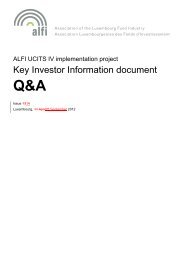Real Estate Investment Funds: Financial reporting - Alfi
Real Estate Investment Funds: Financial reporting - Alfi
Real Estate Investment Funds: Financial reporting - Alfi
You also want an ePaper? Increase the reach of your titles
YUMPU automatically turns print PDFs into web optimized ePapers that Google loves.
discussed above in Chapter III.2.c and<br />
Chapter III.2.d. Key differences include:<br />
The NRV includes a deduction for the<br />
estimated costs of selling the asset which<br />
the fair value of the asset will not; and<br />
The fair valuation of a property under<br />
construction, as discussed, in III.2.c, may<br />
include a deduction for the anticipated profit<br />
to be achieved on development which will<br />
not be the case for the NRV of inventory<br />
where no such margin is deducted.<br />
4. Is there a<br />
requirement to carry<br />
debt at fair value?<br />
a. Normally, the carrying value of variable<br />
interest debt arrangements approximates its<br />
fair value and such debt should be carried at<br />
amortised cost using the effective interest rate<br />
method under both IFRS and LuxGAAP.<br />
b. INREV requires that fixed interest debt is<br />
carried at fair value. If economically justifiable,<br />
however, the fund documentation may provide<br />
a derogation from this principle so that fixed<br />
rate debts are recorded at amortised cost<br />
(rather than at fair value) dependent on how<br />
the debt will be settled. This could be<br />
acceptable in various instances, including:<br />
For closed ended funds where the fixed rate<br />
debts are almost certainly held until maturity,<br />
the liabilities may be valued at their amortised<br />
cost to avoid the impact of unrealised changes<br />
in the fair value of the instrument on the NAV<br />
during the life of the fund. This is in line with<br />
the INREV guidance for closed ended funds<br />
when determining the "NAV for property<br />
performance measures" as well as best<br />
practice in respect of the valuation of<br />
derivative hedging instruments;<br />
For open-ended funds where, again, the fixed<br />
rate debts are almost certainly held till<br />
maturity and Fund management, therefore,<br />
do not believe that it is appropriate that the<br />
trading NAV of the fund is impacted by<br />
volatility in the fair value of fixed rate debts.<br />
The assessment of the intended purpose of<br />
fixed rate debts should be re-considered at<br />
each NAV calculation date to substantiate<br />
the adjustment to value at nominal amount<br />
for the purpose of the NAV calculation. In<br />
any case, the fair value of fixed rate debt<br />
should be disclosed in the notes to the<br />
financial statements. Use of such derogations<br />
should be discussed with the fund’s auditors.<br />
c. Under IFRS, there are both fair value and<br />
amortised cost options depending on the<br />
classification as of the financial liability per<br />
IAS 39. If the cost model is adopted as<br />
described above, the fair value should be<br />
disclosed in the notes to the financial<br />
statements. In IFRS financial statements, if<br />
fixed rate debt is carried at amortised cost,<br />
a reconciling item to arrive to the Fund NAV<br />
may be necessary.<br />
See Chapter III.10 for related guidance regarding<br />
accounting for currency and interest rate hedges.<br />
5. How is revenue<br />
recognised in a real<br />
estate fund?<br />
a. Under IFRS rental income and all rent<br />
incentives should be recognised on a straight<br />
line basis over the term of the rental agreement<br />
unless another systematic basis of recognition<br />
is more representative of the time pattern of<br />
which the REIF’s benefit derived from the<br />
property is diminished. This means that all rent<br />
incentives, such as rent free periods, moving<br />
subsidies etc., should be straight lined unless<br />
the other circumstances noted above apply.<br />
This is implemented through movements in<br />
balance sheet accounts. LuxGAAP is consistent<br />
with IFRS in this regard in that it allows other<br />
methods of income recognition in addition to<br />
straight-lining if these are more appropriate<br />
based on the fund style.<br />
b. One of the issues of applying this accounting<br />
principle is that revenue and cash flows from<br />
revenues are not matched.<br />
This means that definitions of distributable<br />
income often need to be adapted to revert to<br />
recognising revenue when contractually due<br />
and billable. Also, this is a common practice<br />
in many countries from a tax perspective.<br />
c. When applying the fair value model, it is<br />
important to avoid double counting of assets<br />
if the lease contract includes a rent-free or a<br />
period of reduced rent. The double counting<br />
results because the leases are straight-lined<br />
over the period of the lease, resulting in a<br />
lease receivable in the period of reduced rent/<br />
rent free period. The fair value model<br />
15

















